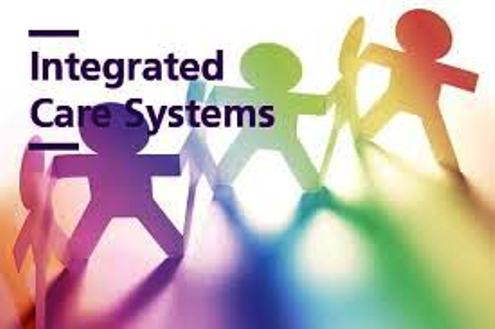
There are different levels of services integration. The Substance Abuse and Mental Health Service Administration (SAMHSA) designed a framework to help health care providers plan and support an integrated system. That framework has three main categories:
- Coordinated Care, which concentrates on communication
- Co-located Care, which focuses on physical proximity
- Integrated Care, which emphasizes practice change.
Within each category, there are varying degrees of collaboration between care providers. These levels range from minimal to full integration. Minimal integration is when medical and mental health care providers work in separate facilities, have separate systems, and rarely communicate. Full integration involves a single health system’s medical and mental health care providers working simultaneously to treat a patient’s behavioral and medical needs with shared medical record access.
The following are examples of Integrated Care programs:
Collaborative Care
A team-based Collaborative Care program adds two new types of services to usual primary care: behavioral health care management and consultations with a mental health specialist.The behavioral health care manager becomes part of the patient’s treatment team and helps the primary care provider evaluate the patient’s mental health. If the patient receives a diagnosis of a mental health disorder, and wants treatment, the care manager, primary care provider, and patient work together to develop a treatment plan. This plan may include medication, psychotherapy, or other appropriate options.
Later, the care manager reaches out to see if the patient likes the plan, is following the plan, and if the plan is working or if changes are needed. The care manager and the primary care provider also regularly review the patient’s status and care plan with a mental health specialist, like a psychiatrist or psychiatric nurse, to be sure the patient is getting the best treatment options and improving.
Patient-Centered Medical Home (PCMH)
Another Integrated Care model is the patient-centered medical home (PCMH). PCMH involves coordinating a patient’s overall health care needs at any age. Patients play active roles in their health care. Providers coordinate all aspects of preventive, acute, and chronic needs of patients using the best available evidence and appropriate technology.As a result of the Affordable Care Act, health homes were established for individuals on Medicaid with chronic conditions including mental health and substance use disorders, asthma, diabetes, heart disease, and obesity. Health homes are team-based with a whole-person approach with specific emphasis on integrating behavioral health and primary care. Health homes provide comprehensive care management, coordination, and follow-up. They also offer patient and family support, referrals to community and support services, and health promotion.
Hub-Based Systems
Found mostly in the child mental health world, hub-based systems modeled on the Massachusetts Child Psychiatry Access Project (MCPAP) provide primary care providers with immediate telephone consultations with a child psychiatrist. Case management and face-to-face evaluations are also available for complicated cases.Four Quadrant Model
The Four Quadrant Model is a way to measure an organization’s level of integration.The Four Quadrant Clinical Integration Model describes integration levels in terms of primary care and behavioral health care complexity and risk. The location, types of providers, and services vary depending on the complexity of patients’ conditions.
For instance, individuals with mild-to-moderate physical and/or behavioral health issues may be best cared for in a primary care setting with integrated behavioral health providers. For patients with complex general medical conditions as well as mild-to-moderate behavioral health disorders, a medical specialty setting with integrated behavioral health providers may be appropriate.
Those with severe behavioral problems as well as medical conditions may receive the most comprehensive care in a specialty behavioral health center with integrated general medical providers, or a health home.
Pediatric versus Adult Integrated Care
Pediatric Integrated Care differs from adult Integrated Care in three main ways:- There is an increased sensitivity to how children are developing, both mentally and emotionally
- Families play an important role
- Treatment emphasizes coping and adjustment techniques in addition to standard care
The general principles of Integrated Care apply to adults as well as children and adolescents, but work with developing youth and their families is often different from the work with adults with complex medical illness. In addition, ongoing evaluation for intellectual disability and developmental delays will be emphasized in pediatric evaluations.
This health news has been brought to you by the publishers of Health Reviews, Tips and News Website. Visit today for great health tips and reviews.



No comments
Post a Comment